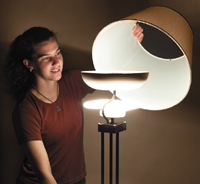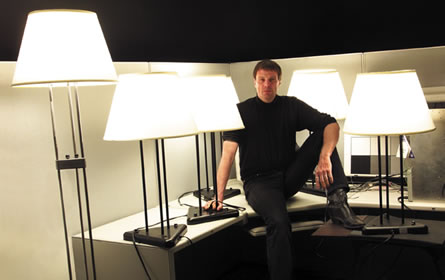The phone started ringing and hasn't stopped," says Michael
Siminovitch, a scientist in Berkeley Lab's Environmental Energy
Technologies Division. Siminovitch and fellow lab scientist
Erik Page are the brains behind the Berkeley Lamp.
|
|
 |
|
| |
 |
| The Berkeley Lamp uses
two fluorescent bulbs to create both an upward and downward
light, each independently controlled. |
|
| |
|
At full power, the two-lamp fluorescent system exceeds the
combined luminous output of a 300-watt halogen lamp and a
150-watt incandescent lamp while using a quarter of the energy.
More important, people like it.
That's no coincidence. For the past several years, Siminovitch
has worked to package efficient lighting in an easy-to-use
and good-looking lamp. That's because the most energy efficient
light is useless if people don't like it. When testing prototypes,
Siminovitch even relied more on what office workers said than
on what his lab tests revealed. And what they said prompted
him to rethink how America lights its offices.
First, overhead fluorescent lighting doesn't work well, at
least for most people. Conventional overhead lighting is harsh
and can cause glare on computer screens. Second, overhead
lighting is either on or off. It can't be customized to suit
different people and different tasks. One person might want
diffuse upward light for general illumination, while another
needs intense downward light to read a stack of reports.
"Older-style ceiling fixtures can't easily adapt to these
demands because the way they're used hasn't changed in 50
years," says Siminovitch.
Overhead lighting isn't the only problem. The typical halogen
torchiere lamp used in many home offices consumes hundreds
of watts and burns up to 1,000 degrees Fahrenheit --so hot,
they're banned in many dormitories.
Time for something new. The Berkeley Lamp sports two high-performance,
compact fluorescent lamps, each fully dimmable and independently
controlled. Separated by a reflector bowl, one lamp projects
light downward to illuminate the desk, the other projects
light upward to provide indirect, ambient lighting. The lamps
can be used together or separately. A user can control both
light intensity and distribution, making it applicable to
many office tasks and environments.
The Berkeley Lamp also emits light uniformly, meaning no
glaring, eye-fatiguing hotspots. And it looks good. Its sleek
design and easy controls ensure that any desk can accommodate
it and anyone can use it. These advantages give people the
power to create their own lighting, instead of coping with
whatever was installed in their office years ago.
|
| "Energy
efficient light is useless if people don't like it." |
|
"Some of our success can be attributed to this push-pull
dynamic: poor lighting everywhere and a good alternative,"
says Siminovitch.
Even so, Siminovitch remained modest at first, anticipating
the lamp would be used mostly in homes and hotels. Then came
the energy crisis, and those ubiquitous overhead office lights
came under scrutiny. Although they consist of energy-efficient
fluorescent bulbs, they're not used efficiently. A typical
office space may have eight desks and eight people, but only
one light switch. An early bird comes in at 6:00 am and turns
on the lights, which burn continuously until the last person
leaves at 10:00 pm. Even at noon, when everyone goes to lunch,
the lights remain on.
Instead, why not turn off the overhead lights, place a Berkeley
Lamp on each desk, and save energy--which is what officials
did in the City of Berkeley's Public Works Engineering Office
in the fall of 2001. They installed 18 lamps in a room filled
with cubicles and cut lighting costs by 58 percent. And they
expect the investment to pay for itself in three years. This
approach works particularly well in offices with older lighting
systems and in offices that are over-illuminated.
"It's better light and it saves energy," Siminovitch
says. "If every person in California had one on their
desk, it wouldn't erase the summer power problem, but it would
help immensely."
|
 |
| |
| Michael Siminovitch, a scientist in
the Lab's Environmental Energy Technologies Division,
with the Berkeley Lamp. The two-lamp fluorescent system
exceeds the combined luminous output of a 300-watt halogen
lamp and a 150-watt incandescent lamp while using a quarter
of the energy. |
| |
His optimism is spreading. Siminovitch recently returned
from Hawaii, where he helped install 50 lamps at Hickam Air
Force Base and several more at the mayor's office in Honolulu.
Closer to home in San Francisco, the Fort Mason Center acquired
100 lamps. The Berkeley Lamp is also an inexpensive retrofit
alternative. Instead of stripping old fixtures and rewiring
a room, the National Park Service plans to achieve a 50 percent
reduction in lighting costs in every office that installs
the lamps and turns off overhead lights.
The Berkeley Lamp works best when it can share the lighting
workload with other Berkeley Lamps--that means mid-sized rooms
of between two and ten cubicles, an arrangement that accounts
for a large percentage of offices in the U.S.
So far, about 6,000 lamps are in use throughout the U.S.,
and not only in offices. Several Sacramento area hotels are
testing it, and physics Nobel Laureate Don Glaser uses two
in his Berkeley home. It's manufactured and distributed by
the Light Corporation of Grand Haven, Michigan.
Siminovitch is currently developing Berkeley Lamp II, a smarter
version with a motion-sensing switch and controls that remember
a person's preferred settings. But don't expect its look to
change. Regardless of how high-tech it becomes, the Berkeley
Lamp will remain an everyday lamp to be used like any other
lamp.
"It's meant to be embraceable, not strange or futuristic,"
Siminovitch says. "It's just a basic table lamp that's
not so basic."
-- Dan Krotz
|



